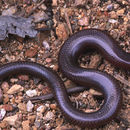en
names in breadcrumbs


Brachymeles tridactylus is one of only two currently recognized species in the genus Brachymeles to possess three fingers and three toes. The other known three-digit species is B. muntingkamay, a morphologically similar species. It is a small and slender species with a moderately wide distribution in the central Philippine islands, at least when compared to the smaller known ranges of many of the non-pentadactyl species in the genus. The genus Brachymeles represents a unique group of semi-burrowing (semi-fossorial) lizards in that the group possesses species with a full spectrum of body forms, from limbed species with five fingers and five toes, to fully limbless species. Researchers are interested in the process and patterns behind the evolution of these drastic changes in body form. With the exception of two species from Borneo (B. apus) and Thailand (B. miriamae), all species of Brachymeles are endemic to the Philippines. This means they are found among the more than 7,000 Philippine islands and nowhere else in the world.
We have evaluated this species against the IUCN criteria for classification, and find that it does not qualify for Critically Endangered, Endangered, Vulnerable, or Near Threatened status. Brachymeles tridactylus has been documented to have a broad geographic distribution and is quite abundant at all sampled localities. We therefore classify this species as Least Concern, LC (IUCN, 2010).
Brachymeles tridactylus can be distinguished from congeners by the following combination of characters: (1) body size small (SVL 45.5–78.3 mm); (2) limbs tridactyl; (3) limb length small; (4) supralabials six or seven; (5) infralabials six or seven; (6) suparciliaries five; (7) supraoculars four; (8) midbody scale rows 19–22; (9) axilla–groin scale rows 70–79; (10) paravertebral scale rows 88–98; (11) pineal eye spot present; (12) prefrontals not contacting on midline; (13) frontoparietals not contacting on midline; (14) mental/1st infralabial fusion absent; (15) postnasals absent; (16) enlarged chin shields in three pairs; (17) nuchal scales differentiated; (18) auricular opening absent; and (19) presacral vertebrae 47.
Brachymeles tridactylus is recognized to occur in the Visayan (Central) Pleistocene Aggregate Island Complex.
SVL 45.5–78.3 mm
The three-fingered short-legged skink (Brachymeles tridactylus) is a species of skink endemic to the Philippines.[2]
The three-fingered short-legged skink (Brachymeles tridactylus) is a species of skink endemic to the Philippines.